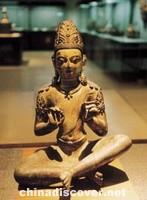
The Tibet Museum, located in the southeastern corner of Norbu Lingka, Lhasa, is the first of its kind in Tibet to be provided with the latest in equipment and facilities. The Tibet Museum was completed and opened in October 1999.
The Tibet Museum has a huge collection of art treasures. Its exhibits include prehistoric cultural relics, Buddhist statues carved in various materials and in different postures, and Tibetan sutras hand written in powdered gold, silver and coral. There are also colorful thangkas, and a wide range of Tibetan utensils and ritual implements, handicrafts, and ceramics.
On its inauguration, the museum held an exhibition named "Tibetan History and Culture", which included scenes from the Prehistoric Age, depictions of Tibet's ancient culture and history, and examples of its folk customs. This exhibition was designated one of the "Top Ten National Exhibitions in 1999" by the State Cultural Relics Bureau, the Chinese Association of Museums, and the China Cultural Relics Journal.
The more than 1,000 historical relics on display reflect the splendid culture and long history of Tibet, which naturally encompasses the major aspects of its religion and folk customs.
Covering an area of 53,959 square meters, the museum is superbly laid out. Along its central axis are the Introductory Hall, Main Exhibition Hall and Storehouses of Cultural Relics. The museum building is distinctive for its traditional Tibetan architecture, and its interior is impressive for its authentically Tibetan structural style of ornamented beams, pillars and lintels in the Introductory Hall, while the column heads and ceilings in its exhibition halls are decorated with banners and wall hangings.
The exhibit showcases are unique for their eight auspicious designs of red copper.
The Tibet Museum is used for storing and preserving cultural relics, as well as for academic research. The latest in high-tech is employed to ensure top notch service, safety, and efficient administration of the museum, and all exhibits are described in Tibetan, Chinese, Japanese and English. (Source: China Today)
